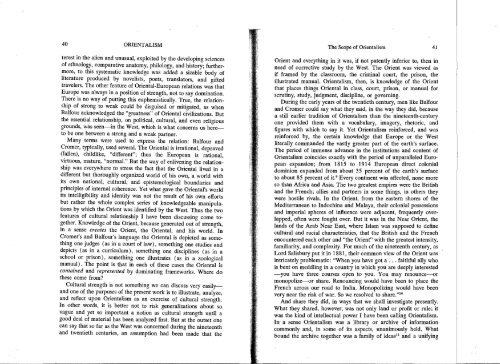Orientalism - autonomous learning
Orientalism - autonomous learning
Orientalism - autonomous learning
Create successful ePaper yourself
Turn your PDF publications into a flip-book with our unique Google optimized e-Paper software.
40<br />
ORIENTALISM<br />
terest in the alien and unusual, exploited by the developing sciences<br />
of ethnology, comparative anatomy, philology, and history; furthermore,<br />
to this systematic knowledge was added a sizable body of<br />
literature produced by novelists, poets, translators, and gifted<br />
travelers. The other feature of Oriental-European relations was that<br />
Europe was always in a position of strength, not to say domination.<br />
There is no way of putting this euphemistically. True, the relationship<br />
of strong to weak could be disguised or mitigated, as when<br />
Balfour acknowledged the "greatness" of Oriental civilizations. But<br />
the essential relationship, on political, cultural, and even religious<br />
grounds, was seen-in the West, whioh is what concerns us hereto<br />
be one between a strong and a weak partner.<br />
Many terms were used to express the relation: Balfour and<br />
Cromer, typically, used several. The Oriental is irrational, depraved<br />
(faIlen), childlike, "different"; thus the European is rational,<br />
virtuous, mature, "normal." But the way of enlivening the relationship<br />
was everywhere to stress the fact that the Oriental lived in a<br />
different but thoroughly organized world of his own, a world with<br />
its own national, cultural, and epistemological boundaries and<br />
principles of internal coherence. Yet what gave the Oriental's world<br />
its intelligibility and identity was not the result of his own efforts<br />
but rather the whole complex series of knowledgeable manipulations<br />
by which the Orient was identified by the West. Thus the two<br />
features of cultural relationship I have been discussing come together.<br />
Knowledge of the Orient, because generated out of strength,<br />
in a sense creates the Orient, the Oriental, and his world. In<br />
Cromer's and Balfour's language the Oriental is depicted as something<br />
one judges (as in a court of law), something one studies and<br />
depicts (as in a curriculum), something one disciplines (as in a<br />
school or prison), something one iIlustrates (as in a zoological<br />
manual). The point is that in each of these cases the Oriental is<br />
contained and represented by dominating frl;lmeworks. Where do<br />
these come from?<br />
Cultural strength is not something we can discuss very easilyand<br />
one of the purposes of the present work is to illustrate, analyze,<br />
and reflect upon <strong>Orientalism</strong> as an exercise of cultural strength.<br />
In other words, it is better not to risk generalizations about so<br />
vague and yet so important a notion as cultural strength until a<br />
good deal of material has been. analyzed first. But at the outset one<br />
can say that so far as the West was concerned during the nineteenth<br />
and twentieth centuries, an assumption had been made that the<br />
The Scope of <strong>Orientalism</strong><br />
Orient and everything in it was, if not patently inferior to, then in<br />
need of corrective study by the West. The Orient was viewed as<br />
if framed by the classroom, the criminal court, the prison, the<br />
illustrated manual. <strong>Orientalism</strong>, then, is knowledge of the Orient<br />
that places things Oriental in class, court, prison, or manual for<br />
scrutiny, study, judgment, discipline, or governing.<br />
During the early years of the twentieth century, men like Balfour<br />
and Cromer could say what they said, in the way they did, because<br />
a still earlier tradition of <strong>Orientalism</strong> than the nineteenth-century<br />
one provided them with a vocabulary, imagery, rhetoric, and<br />
figures with which to say it. Yet <strong>Orientalism</strong> reinforced, and was<br />
reinforced by. the certain knowledge that Europe or the West<br />
literally commanded the vastly greater part of the earth's surface.<br />
The period of immense advance in the institutions and content of<br />
<strong>Orientalism</strong> coincides exactly with the period of unparalleled European<br />
expansion; from 1815 to 1914 European direct colonial<br />
dominion expanded from about 35 percent of the earth's surface<br />
to about 85 percent of it. 9 Every continent was affected, none more<br />
so than Africa and Asia. The two greatest empires were the British<br />
and the French; allies and partners in some things, in others they<br />
were hostile rivals. In the Orient, from the eastern shores of the<br />
Mediterranean to Indochina and Malaya, their colonial possessions<br />
and imperial spheres of influence were adjacent, frequently overlapped,<br />
often were fought over. But it was in the Near Orient, the<br />
lands of the Arab Near East, where Islam was supposed to define<br />
cultural· and racial characteristics, that the British and the French<br />
encountered each other and "the Orient" with the greatest intensity,<br />
familiarity, and complexity. For much of the nineteenth century, as<br />
Lord Salisbury put it in 1881, their common view of the Orient was<br />
intricately problematic: "When you have got a ... faithful ally who<br />
is bent on meddling in a country in which you are deeply interested<br />
-you have three courses open to you. You may renounce--or<br />
monopolize-or share. Renouncing would have been to place the<br />
French across our road to India. Monopolizing would have been<br />
very near the risk of war. So we resolved to share."lQ<br />
And share they did, in ways that we shall investigate presently.<br />
What they shared, however, was not only land or profit or rule; it<br />
was the kind of intellectual power I have been calling <strong>Orientalism</strong>.<br />
In' a sense <strong>Orientalism</strong> was a library or archive of information<br />
commonly and, in some of its aspects, unanimously held. What<br />
bound the archive together was a family of ideas ll and a unifying<br />
41
















